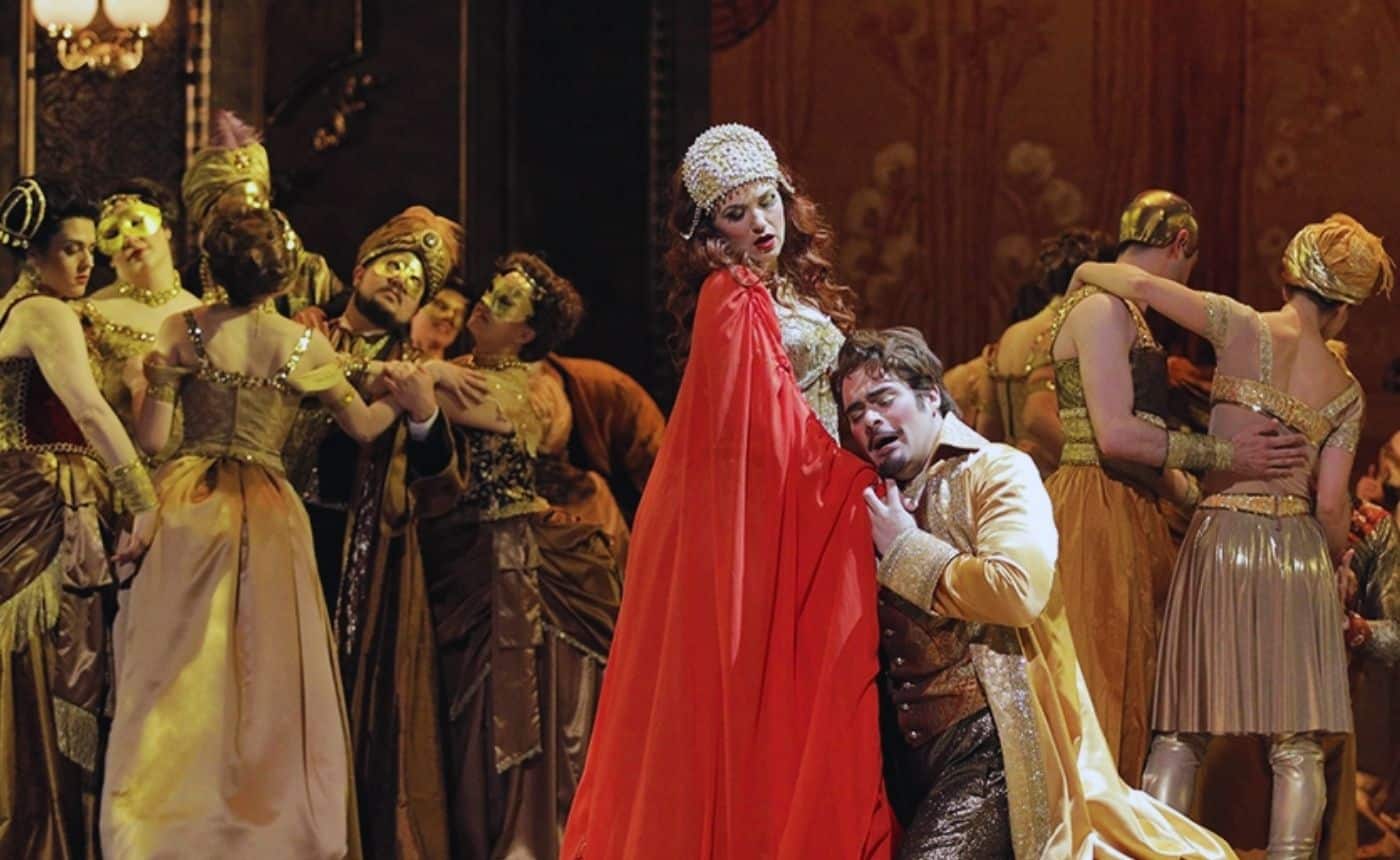The Flying Dutchman Online Course by Dr. Carol AndersonTen Memorable Operatic Storms
by Dr. Carol Anderson
Stormy Weather…
Le tempeste, Die Stürme, bouřky, storms – in any language violent weather mirrors the violent or unpredictable impulses of human nature. Storms in opera also serve to establish or advance the plot. Let’s be honest, had he not had to shelter from a storm, Daland would never have met the Dutchman, and Die fliegende Holländer would have no story to tell. Even more “meta,” had Wagner himself not experienced a terrifying storm on a sea voyage, the subject might never have crossed his mind. With opera being a powerful mirror of passionate behaviors, it’s only natural that musical storms should appear throughout operatic history. Here’s a list of thrilling operatic storms.
Georges Bizet’s The Pearl Fishers (1863)
High Priestess Leïla and Nadir are discovered by Zurga, Nadir’s best friend and romantic rival. As chief of the Ceylonese village, he demands that the lovers be put to death. The villagers agree that there is to be no mercy for the offenders. As a violent storm reaches its peak, the villagers fear the anger of Brahma is directed at their home, and they pray fervently for the god’s protection.
Jennifer Higdon’s Cold Mountain (2015)
In this retelling of the Odyssey, Civil War deserter Inman encounters obstacles, danger, and fascinating characters as he journeys back to his lover Ava. He is traveling with the itinerant preacher Veasey when they encounter the Home Guard, who are tasked with capturing and prosecuting deserters. They escape via the river, but their boat capsizes in the storm.
Thomas Adés’ The Tempest (2004)
The titular tempest depicted in this overture is conjured by Prospero in an act of vengeance against his brother Rodrigo. Rodrigo and his courtiers are shipwrecked and marooned on Prospero’s island. The wildly effective production I saw in Santa Fe had the shipwrecked characters emerging from a hidden tank of water directly above the orchestra pit onto the island set, a definite “how’d they do that?” moment!
Gioachino Rossini’s Il barbiere di Siviglia (1816)
Several of Rossini’s operas contain a Temporale, but the storm in Barber of Seville is probably his best-known. The storm begins gently but builds quickly to a lightning- and wind-filled climax. The rain peters out as quickly as it increased, and a hush falls over the stage before the comic antics resume. Incidentally, Rossini, ever the self-plagiarizer, recycled this storm from his 1812 opera La pietra del paragone. Look to William Tell, La cenerentola, and Le comte Ory for additional temporali italiani!
Ethel Smyth’s The Wreckers (1906)
This dramatic tale of Cornwalllife is a clear antecedent to Britten’s masterpiece Peter Grimes. Cornish residents would light bonfires on the rocky cliffs to lure unsuspecting ships to their doom on the rocks. The impoverished villagers would then lay claim to the wrecked ship and all the goods contained in her hold. Ethel Smyth’s overture sets the scene perfectly, interspersing Romantic themes with stormy percussion and other tempestuous orchestra effects.
Hector Berlioz’s Les Troyens (1863)
Act 4 of Berlioz’s immense opera opens with a pantomime entitled “Royal Hunt and Storm.” A pastoral scene is interrupted by the appearance of the royal hunt. As a storm breaks, Queen Dido and her lover Aeneas are separated from the group and shelter together in a cave. The wildness of the storm stirs the mythical residents of the forest to a frenzy which subsides as the weather calms.
Leoš Janáček’s Kát’a Kabanova (1921)
Based on a play entitled “The Storm,” by Alexander Ostrovosky, Kát’a details the impact an adulterous love triangle has on a small Russian town on the banks of the Volga River. In this scene, townspeople take refuge from a sudden storm. A discussion ensues about lightning: is it a physical phenomenon or a punishment for one’s sins? Kát’a enters the shelter and confesses to her liaison with Boris, and flees into the storm where she pays the ultimate price for her actions.
Giuseppe Verdi’s Rigoletto (1851)
Rigoletto has arranged for the Duke of Mantua, despoiler of his beloved daughter Gilda, to be murdered by the assassin Sparafucile. Maddalena, Sparafucile’s sister, is enamored of the Duke and pleads for his life. Sparafucile reluctantly agrees, provided another victim presents themself prior to his deadline. Gilda overhears the conversation and resolves to sacrifice herself for her beloved Duke, despite his unworthiness. In addition to the brilliant orchestra portrayal of the emotional and actual storm, the swirling winds are depicted through wordless chromatic passages sung offstage by a chorus of tenors and basses.
Daniel Catán’s Florencia en el Amazonas (1998)
During a transformational voyage up the Amazon, the passengers aboard the El Dorado nearly lose their lives in a sudden torrential rainstorm. The storm serves as a pivot point for each of the characters’ journeys. True to the magical realism of the libretto, the rain that falls is mysteriously pink and the passengers are saved in part through an incantation to the river gods.
Giuseppe Verdi’s Otello (1887)
Verdi makes the list a second time with this storm that quite literally blows the new governor Otello and his soldiers into safe harbor, fresh from their triumph in battle against the Turks. The danger of the storm highlights the vulnerability of the characters to the elements of nature and sets the scene for their downfall via the elemental and violent emotions of humanity.
Benjamin Britten’s Peter Grimes (1945)
Arguably the greatest opera of the twentieth century, Britten’s masterwork is set in a fictional coastal village in Sussex, quite close to Britten’s own home of Aldeburgh. The small-minded and judgmental villagers can neither understand nor accept Peter, a peculiar outlier in the village. The meteorological storm portrayed in the second interlude foreshadows the societal storm yet to come.
AND A BONUS SEA MONSTER
When Idomeneo, King of Crete, breaks a vow he has made to the god Neptune, the angry deity sends a sea monster to menace the kingdom.





